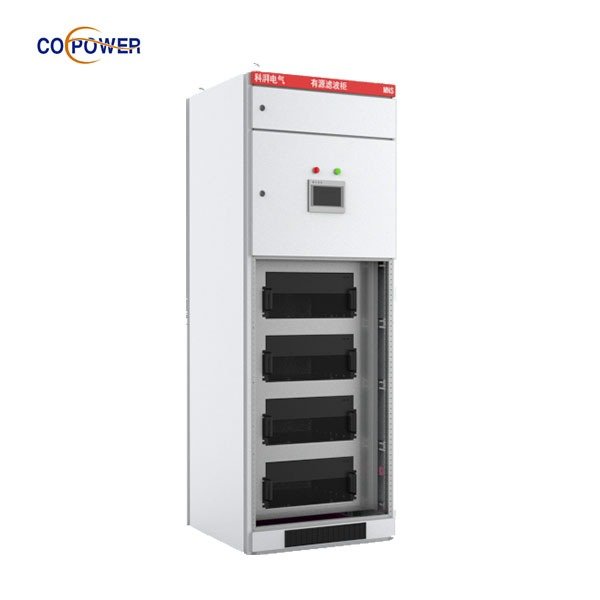Dans les réseaux électriques modernes - en particulier ceux qui alimentent les installations industrielles, centres de données, et bâtiments commerciaux - distorsion harmonique créée par des charges non linéaires (comme VFDS, Systèmes UPS, et les pilotes LED) poses a significant challenge to power quality. Selecting the right harmonic mitigation strategy is key. This blog dives into Active Harmonic Filters (Ahfs) versus Passive Harmonic Filters (PHFS) and guides you on when to opt for each—integrating insights from Solutions de filtre harmonique active de CoePower.
Passive Harmonic Filters (PHFS)
PHFs use traditional components—inductors, condensateurs, resistors—tuned to target specific harmonic frequencies. They’re simple and cost-effective, ideal for predictable, static systems where harmonic content doesn’t vary. But they:
-Operate only at pre-designed frequencies
-Can suffer from resonance issues
-May introduce a leading power factor when unloaded
Filtres harmoniques actifs (Ahfs)

AHFs represent a modern, dynamic solution. They continuously monitor harmonic disturbances using sensors and a DSP, then inject compensating currents to neutralise those harmonics in real time
Advantages include:
-Real-time adaptation to load changes
-Targeting a broad range of harmonics
-No leading power factor at low load
-Flexible installation points (e.g. at PCC or switchboards)
When to Choose a Passive Filter
Mieux pour:
-Single, stable harmonic sources—like a solitary VFD with a known frequency
-Budget-constrained projects—lower upfront cost; lower maintenance
-Applications with predictable loads—SCADA systems, specific motor drives, etc..
Inconvénients:
-Inflexible to changes in system load
-Risk of resonance and inefficiency under varying conditions
-Requires tuning per device—can become costly if scaled across
When to Choose an Active Filter
Ideal for:
-Complex systems with multiple, variable loads—data centers, multi-VFD plant environments
-Applications requiring ultra-low THD (e.g. IEEE-519 limits: <5–8%)—AHFs remain effective even at low load
-Centralized installations (point-of-common-coupling vs per-VFD) offering installation flexibility
-Systems needing reactive power compensation or three-phase balancing
Trade-offs:
-Higher initial cost
-Requires skilled planning and configuration
-Slightly higher maintenance due to electronics—but offers superior long-term performance
CoEpower’s Active Harmonic Filter: Advantages in Focus
Integrating CoEpower’s APF insights elevates this decision-making:
Dynamic Harmonic Mitigation: Leverages high-speed DSP algorithms to monitor and compensate harmonic currents in real time.
Flexible Form Factors: Offers rack-mounted, wall-mounted, and cabinet-integrated options for seamless deployment.
Fast Response & High Accuracy: Ideal for demanding applications where precision and speed are paramount.
Évolutivité: Modular designs facilitate easy expansion as load profiles evolve; perfect for growing operations.
Quick Comparison Table
| Criteria | Passive Harmonic Filters (PHFS) | Filtres harmoniques actifs (Ahfs) – CoEpower |
|---|---|---|
| Best Use Case | Stable single-source harmonics | Variable, multi-load systems |
| Cost | Low CapEx, minimal maintenance | Higher CapEx, minimal long-term costs |
| Adaptability | Fixed-frequency tuning only | Real-time, comprehensive compensation |
| Installation | At each harmonic source | Centralized or flexible placement |
| Performance | Adequate for basic THD control | Superior across load range, even under light load |
| Facteur de puissance | May cause leading PF | Maintains PF, sometimes improves it |
| Size & Modularity | Volumineux, per-device | Compact, modular, scalable |
| CoEpower Features | — | DSP-based, multiple mounting, réponse rapide |
Conclusion
-Passive filters shine in simple, budget-conscious, and stable environments.
-Active filters, especially CoEpower’s APFs, excel where loads fluctuate, precision matters, and future scalability is essential.
Explorez notre page de produit de filtre harmonique actif pour en savoir plus:
By aligning the right filter with your system’s complexity, performance needs, and infrastructure, you ensure optimal power quality, efficiency, and reliability.
Balises: Active vs Passive Harmonic Filters, When to use Active Harmonic Filters, Passive Harmonic Filter advantages/disadvantages, Filtre harmonique actif de CoePower, Harmonic mitigation strategies, Electrical system THD reduction, DSP-based APF technology, Rack-mounted harmonic filter.


